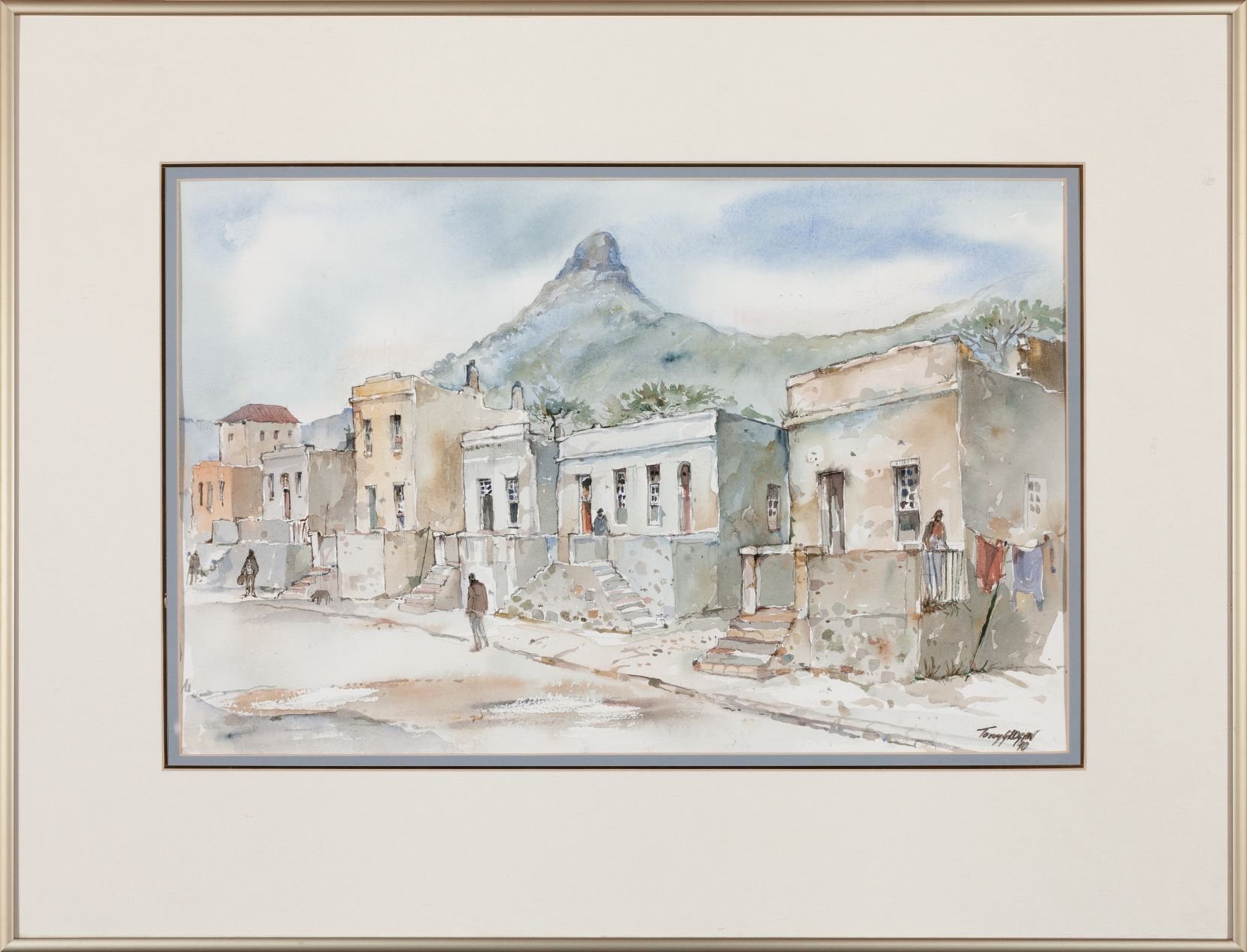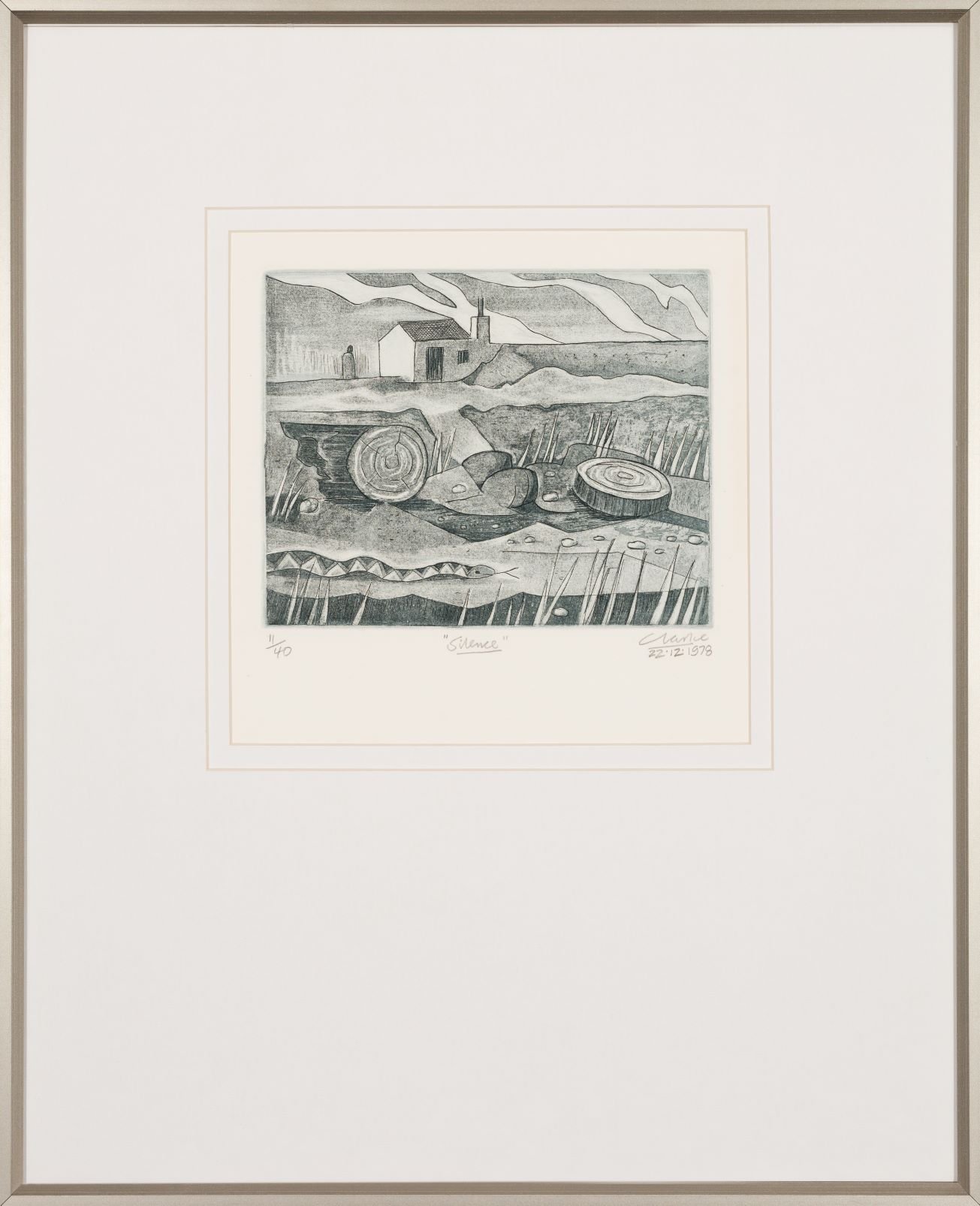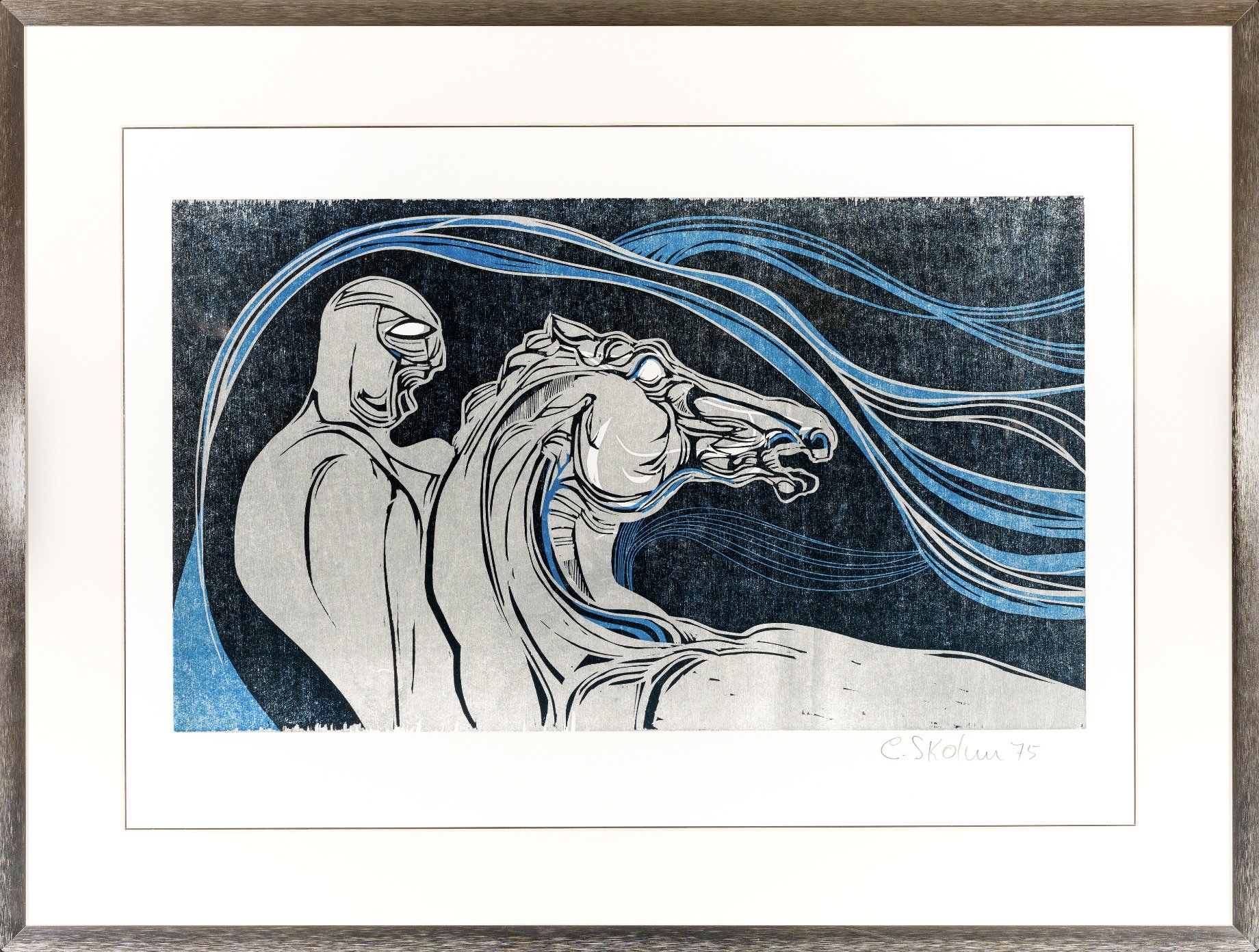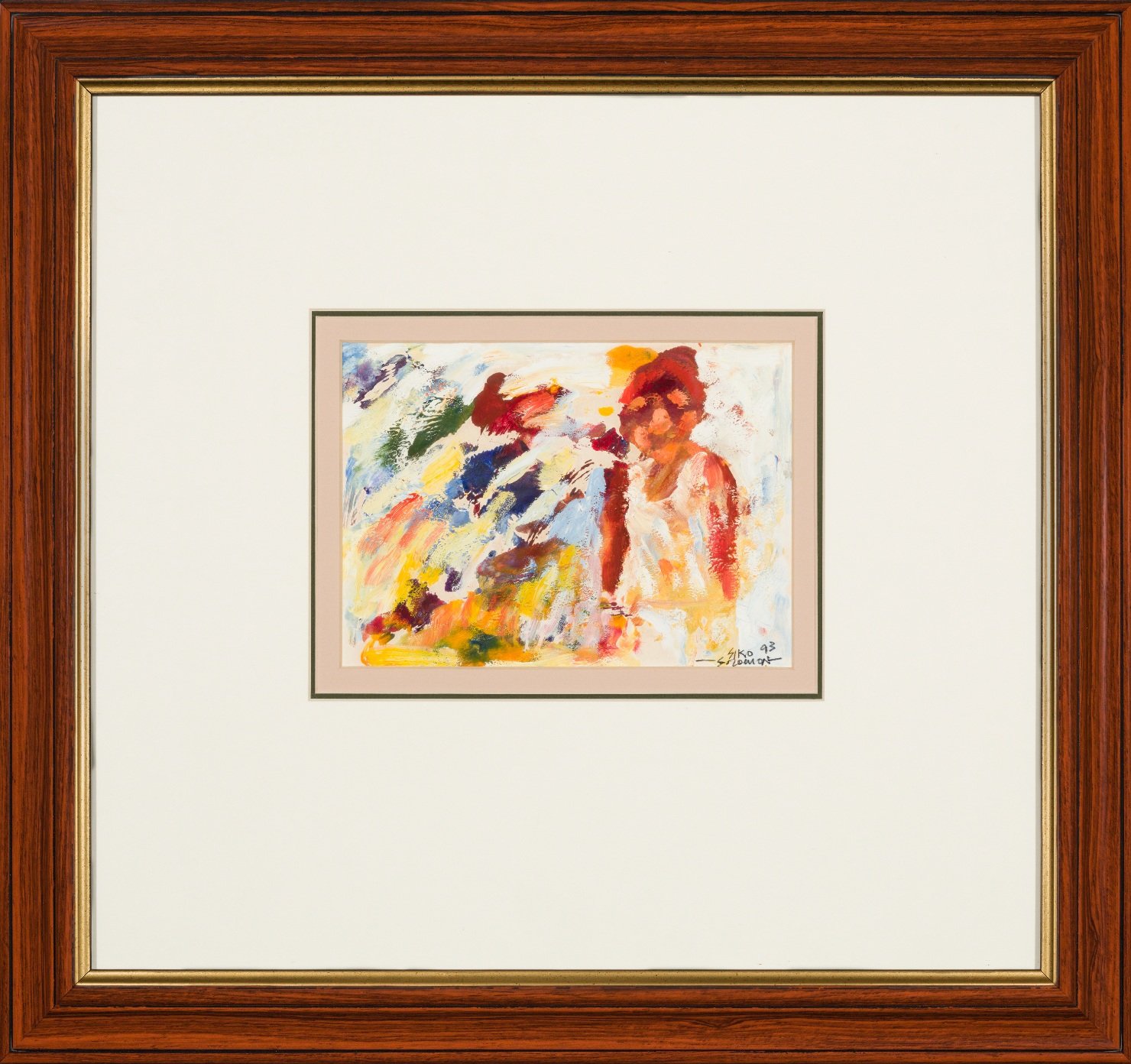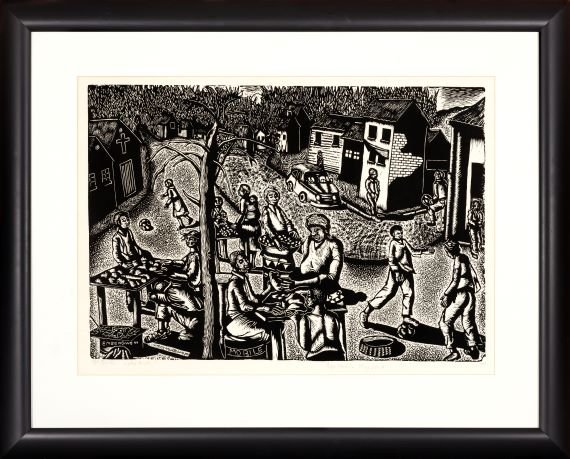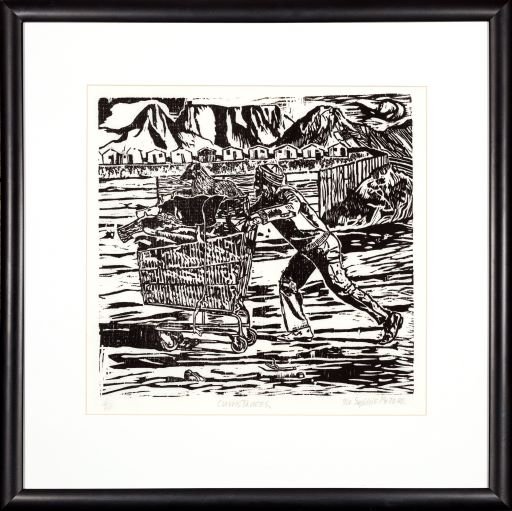Cape Town Conversations - Milieu
Milieu presents an exhibition of artwork from the Cape Town Museum’s collection with the first “conversation” originating from the notion of “place”. What does place comprise and why is it significant; how are people influenced by their surroundings and situations and how does this, in turn, shape their environments?
Place refers to a particular location or position. Whether geographical or a condition of the mind, place is personal to our diverse and distinct experiences. It is something we use to orientate ourselves and attach meaning to. Creative engagement with place often attempts to establish discourse between an environment and its people. In this online exhibition, Cape Town inspires dialogue about the different experiences related to Cape Town as a place, visually presented by acknowledging places of cultural significance like the Bo-Kaap or the traumatic history of District Six, referencing the uniqueness and natural magnificence of the Cape, from Table Mountain to its stormy weather, and showing a variety of lived experiences such as where we live, how we get around and how we prosper, endure, celebrate and contest.
Cape Town Conversations - Milieu shares communal histories and everyday realities, inviting viewers to contribute their own experiences to the living archive that is Cape Town Digital.
Tony Grogan (b.1940), ‘Malay’ Quarter below Lion’s Head, 1990, Watercolour on paper, 34 x 53 cm
The Bo-Kaap is an area of Cape Town, formerly known as the ‘Malay’ Quarter. It is a former racially segregated area, situated on the slopes of Signal Hill above the city centre and is a historical centre of ‘Cape Malay’ culture in Cape Town. Today it owes much of its character to the nature of its domestic architecture, mostly single storey houses with flat roofs painted in a variety of bright colours.
Tony Grogan is a cartoonist, illustrator and artist living in Cape Town. One of the leading figures of South African cartooning, he is the longest serving editorial cartoonist of the Cape Times, having joined the newspaper in 1974. Grogan has chronicled South African history and illustrated adult and children’s books alike. He has exhibited his drawings and paintings and his work is represented in several private and corporate collections.
Tyrone Appollis (b.1957), District Six, Gouache on paper, 50 x 65 cm
The area known as District Six was home to a community representative of diversity in respect of language, religion, economic class and geographical area of origin. It comprised a vibrant community of the former enslaved, merchants, artisans, labourers and immigrants with close links to the city and the port. Under apartheid government District Six was declared a “white group area” under the Group Areas Act of 1950 on 11 February 1966, and by 1982, the social fabric of the community had been destroyed. More than 60 000 people were forcibly removed to barren outlying areas known as the Cape Flats and their houses in District Six were flattened by bulldozers.
Tyrone Errol Appollis is a South African artist, musician and poet. He studied art at the Foundation School of Art in Observatory and under Cecil Skotnes at the Community Arts Project from 1982 to 1986. Appollis has taken part in numerous local and international exhibitions and his work is held in both private and public collections. His colourful artworks reflect the changing times in South Africa during the liberation struggle. Appollis’ work is informed by the notion of art as cross-cultural dialogue and the belief that art can promote political and social reconciliation.
Peter Clarke (1929-2014), Silence, 1978, Etching with aquatint, edition of 40, 38 x 32 cm
Peter Clarke was aware of the dramatic events around him during times of political change and likened this awareness to “listening to distant thunder which brought forth “reverberations you could not ignore”. Clarke also acknowledged his awareness of the situation in his more subtle, pensive works like the etching “Silence” with its atmosphere of isolation. “Silence” is also reminiscent of Clarke’s iconic triptych “Haunted House” (1976) from the same period, which could be considered a landscape of the mind, where silences represent the absences in stories people tell, especially around painful experiences.
Peter Clarke was born in Simon’s Town where he worked in the docks from 1944. He decided to become a full-time artist following a visit to Tesselaarsdal in 1956. He learnt etching at the Michaelis School of Fine Art at the University of Cape Town in 1961. He had a special permit to study as a student of colour at a white institution. Clarke furthered his studies at the Rijksakademie van Beeldende Kunsten from 1962-1963 and did a course in printmaking at the Atelier Nord in Oslo in 1978. In 1967 Clarke and his family were forcibly removed under the Group Areas Act of 1950 and relocated to the Ocean View township where he ran an art workshop for underprivileged children. He was a prolific artist and during a career spanning more than six decades, he worked tirelessly as an artist, poet and author in a broad spectrum of media – painting, printmaking, drawing, collage and his distinctive hand-made artist’s books. His work deals with repression, poverty and dispossession, but the incisive social commentary is tempered by the overriding sense of celebration.
Cecil Skotnes (1926-2009), White Monday Disaster Portfolio, 1975, Series of 13 woodcuts, Edition of 125
The White Monday Disaster
13 Episodes about a man (Wolraad Woltemade) and his borrowed horse from the history of the Cape in 1773, based on the eye-witness report of Charles Peter Thunberg, a Swedish naturalist and surgeon for the Vereenigde Oostindische Compagnie. Woltemade was a Cape Dutch dairy farmer, who died while rescuing sailors from the wreck of the ship De Jonge Thomas in Table Bay on 1 June 1773.
Cecil Skotnes was a South African artist known especially for his painted and incised wooden panels, striking woodblock prints, public murals, tapestries and sculpture, as well as for pioneering a way of producing art that used earth pigments and indigenous wood to construct visual stories about the African past. He was the cultural officer at the Polly Street Art Centre and as well-known as a teacher and mentor, as he was as an artist. His lifelong mission was to nurture talent and encourage creativity, particularly in places where the apartheid government had deliberately excluded this possibility. He was awarded a State President’s gold medal for service to the country and for his contribution to the deracialisation of South African art.
Braam Kruger (1950 - 2008), Bay of storms: a monument on paper in honour of the shipwrecked souls lost in Table Bay at the Cape of Good Hope (plate II from a set or IV), 1983, Lithograph, 49 x 64 cm
Bay of Storms or Table Bay (later renamed the Cape of Good Hope) at the southern end of the Cape Peninsula, was apparently named by Portuguese navigator, Bartolomeu Dias in 1488 on his return voyage to Portugal, after ascertaining the southern limits of the African continent. Known for its stormy weather and rough seas, the Cape is situated at the convergence of the warm Mozambique-Agulhas current from the Indian Ocean and the Benguela current from Antarctic waters.
Braam Kruger completed his studies in graphic design in 1975. Later in life he was also known as a chef, food writer and restaurateur. He was selected for the 100 Vita Art Now-exhibition and his work formed part of the Cape Town Triennials. Kruger was a one-time student of lithography at Frans Masereel’s Centrum voor Grafiek in Belgium. His etchings reveal the hand of a skilled draughtsman. Although proficient across a range of media, Kruger will forever be remembered for his paintings. Encompassing a variety of styles, they range from the fancifully pop and romantically expressionist to the plainly kitsch
Lyn Smuts (b.1941), Table Mountain, 1993, Etching, 45 x 121 cm
Table Mountain is a flat-topped mountain forming an iconic landmark overlooking the city of Cape Town. Table Mountain serves as more than a tourist attraction. For many it symbolises Cape Town and many stories of indigenous and the formerly enslaved people at the Cape as well as present-day communities who live their lives against the backdrop of the mountain slopes.
Lyn Smuts grew up in the Free State where the open space and skies influenced her. She graduated from the Michaelis School of Fine Art of the University of Cape Town in 1972, followed by a BA Honours from the University of Natal, Pietermaritzburg in 1973. She then went on to become a post-graduate student at the Academie voor Schone Kunsten in Ghent in 1976. Smuts has since been involved in various art activities including teaching, running a community arts programme, presenting workshops and retreats and working collaboratively with other artists. She is attracted to etching for its tangibility and the power of expression the dense layering offers. During the political tension of the 1980s and 1990s her work reflected a concern with the human condition. Post 1994 she returned to the natural world, making drawings in situ that were translated into printmaking techniques. Smuts currently explores the visualisation of sound with a special interest in the structures of nature.
Solomon Siko (1965-2007), Kaapse Dokter, 1993, Oil paint on paper, 48 x 51 cm
“Cape Doctor” is the local name for a strong, often persistent and dry south-easterly wind that can be notoriously fierce in and around the Cape Peninsula. The name derives from the local belief that it clears Cape Town of pollution and disease.
Solomon Siko’s artistic consciousness was formed in the aftermath of the Soweto uprising in 1976. He studied Art at the Community Arts Project in Woodstock, Cape Town from 1987 to 1989 and has exhibited at the Cape Gallery since 1992. A keen satirist and visual narrator, he selects images for their strong associative values. He seeks empowerment, participation and a voice for all in a post-colonial world.
Amos Langdown (1930-2006), Three Fishermen, 1994, Oil on paper, 60 x 46 cm
Reflecting on the artwork, historian Joline Young noted that slavery brought many skilled fishermen from the East to the Cape. Enslaved people in coastal areas were also known to supplement scarce diets through fishing. Post slavery, fishing became a traditional occupation for many descendants of people enslaved at the Cape, who passed this skill from one generation to another.
Langdown was a graphic artist and painter of landscapes, town scenes and figures. He produced lithographs, woodcuts, etchings, monotypes, engravings and oil paintings. He grew up in Plettenberg Bay, a small fishing hamlet on the Southern coast of Africa (his father being a one-time open ocean whaler) that has since expanded into a popular coastal holiday resort. Langdown initially studied privately under the guidance of Katherine Harries and was awarded a bursary from the Cape Three-Century Foundation to further his studies at the Rijks Academy in Amsterdam from 1963-1964. In 1988 Langdown completed a BA degree at the University of Port Elizabeth (current day Nelson Mandela Metropolitan Museum) and participated in various international exhibitions. His works also forms part of several prominent private and institutional collections. Langdown’s paintings show a deep understanding of and sympathy for the people and events in the world surrounding him.
Vuyisani Mgijima (b.1962), Free enterprise, 1991, Linocut, 56 x 70 cm
Free enterprise, or the free market, refers to an economy where the market determines prices, products and services rather than the government. Businesses and services are free of government control. Alternatively, free enterprise could refer to an ideological or legal system whereby commercial activities are primarily regulated through private measures. In this artwork, Mgijima depicts informal trading, a form of private enterprise that takes place outside the formal economic system.
Vuyisani Mgijima artwork is infused with memories of a rural childhood, which contrasts strongly with the daily struggles of township life he experienced living in Mitchell’s Plain in the Cape Flats. Mgijima was introduced to art during Winter and Summer School programmes at the University of Fort Hare in Alice. He joined the seminal Community Arts Project in District Six in 1988 and received sponsorship at the end of his first year to further his studies at the Foundation School of Fine Art in Observatory.
Willie Bester (b.1956), Mobile Shop, 1991, 49 x 82 cm, Mixed media collage
Like Mgijima’s work “Free Enterprise”, Willie Bester’s “Mobile Shop” depicts informal trading in the township. According to Stats SA 2021, 17.8% of the countries employment is generated from the informal sector, which is predominantly trade orientated.
Born in the town of Montagu in the Western Cape Province in South Africa, Willie Bester grew up making art from the materials he found in his environment. Bester creates metal sculptures using found material such as old, discarded car parts and tools that give his artwork (particularly his sculptures) a steampunk aesthetic. This style of design uses a historical setting combined with anachronistic technology and his use of found objects has become part of his signature style. Bester has now been established as one of South Africa’s most recognisable and versatile resistance artists for more than three decades. His choices of subject matter have been inspired by the injustices of apartheid, and the disappointment and dismay he feels in response to corruption and social failures in the post-apartheid era.
Sophie Peters (b.1968), Circumstances, 1994, Linocut edition of 20, 28 x 28 cm
Peters states that she tells ‘the real stories as they are’ of things that happen in people’s homes or elsewhere. She says, “we got reasons why things happen in our lives, we are not just here, there are a lot of things that break in our lives.” Carting possessions along in a trolley could indicate circumstances of homelessness in this edition. According to the Western Cape Government resources there were 4 862 homeless people living in Cape Town in 2019. A more recent study conducted by U-Turn, Khulisa Streetscapes and MES released in November 2020, claims that the figure is closer to 14 000 people.
Printmaker, painter and musician, Sophie Peters’ images reflect her personal history, her spiritual connections, and her relationship to the places and times in which she grew up and continues to live.
Peters was born in Johannesburg and moved to Cape Town in 1985, determined to study art. She completed her training at the Community Arts Project (CAP) in 1987. Peters held her first solo-exhibition at the Association of Art in Bellville in 1995 and has since participated in numerous group exhibitions. Her works are included in several institutional collections, and she has completed commissions for, amongst others, the Robben Island Museum and created illustrations for children’s books.
Sue Williamson (b.1941), A Few South Africans: Case no 6831/21, 1985, Photoetching / screenprint collage, 100 x 70 cm, Edition 19/20
A Few South Africans is a 1980s series made under apartheid to celebrate the history of women who played a role in the struggle for freedom. Postcards printed from the series were widely distributed at the time. Case no 6831/21, 1985 is nameless, for she was but one of thousands in the same situation, “Case no 6831/21” had no right to live in Cape Town under apartheid regulations, even though her husband was a contract worker with a Cape Town company. She spent her married life in informal settlements, continually hounded by officials with the threat of detention and deportation constantly over her head. All she wanted was to live as a family with her husband and children.
Born in the United Kingdom, Sue Williamson emigrated with her family to South Africa in 1948 and now lives and works in Cape Town. Trained as a printmaker, Williamson also works in installation, photography and video. In the 1970s and 1980s she made work that addressed social change during apartheid and became well known for her series of portraits of women involved in the country’s political struggle. Williamson’s work features in numerous public collections across the globe and received various awards and fellowships.
Hardy Botha (b.1974), At Home, 1982, Watercolour on paper, 38 x 40 cm
“At Home” offers a glimpse of the private space and the relationship between home and self. The concept of home can cultivate, protect and challenge our identities, or serve as the repository of our private insecurities. The body at home becomes the vehicle to explore our relationship to the spaces we occupy.
Hardy Botha is known for his satirical commentary on South Africa’s apartheid past. He received a diploma in Fine Arts from the former Orange Free State Technical College. He had his first solo-exhibition in 1973 and furthered his studies at the Michaelis School of the Arts from 1979-1980. In 1987 Botha attended the Dakar Dialogue, a historic conference between members of the Institute for Democratic Alternatives in South Africa (IDASA) and the African National Congress (ANC). In the same year he, along with Jan Visser, established the Dal Josaphat Art Foundation in Paarl. Botha lectured at the University of Stellenbosch until 1991.
Marianne Podlashuc (1932-2004), Le vernissage, Mixed media on paper, 61 x 46 cm
A vernissage (from French, originally meaning “varnishing”) is a term used for a preview of an art exhibition, which may be private and takes place before the formal opening. In the context of Podlashuc’s commentary, it could also be considered a reference to how the art world of this period was instrumental in practices of exclusion.
Marianne Podlashuc was born in Holland in 1932, where she lived through the Nazi occupation of the Netherlands during the Second World War. After immigrating to South Africa from Delft in 1952, she settled in Bloemfontein as a practicing artist. Five years later she married the South African artist Alexander Podlashuc with whom she founded the Bloemfontein Group of artists in 1958. The suffering experienced during her formative years had an impact on her as a compassionate human being, but also as an artist whose work would echo a profound awareness of social disparities. This consciousness is particularly reflected in Pordlashuc’s South African work of the 1950s and 1960. Esmé Berman describes the stylised image as a powerful manifestation of Podlashuc’s response to the realities of less privileged local communities.
Alexander Podlashuc (1930-2009), On the balcony, 1970, Linocut, 56 x 38 cm
The contradiction in our relationship with both the harsh and magnificent South African environment is balanced by a tranquil interior like Podlashuc’s balcony scene in its cool tones. Balconies can be likened to notions of being both inside and outside, areas of gathering and memory making, places of expectation in waiting or simply as a place to enjoy the view and contemplate the world passing by.
Alexander Podlashuc was born in Pretoria in 1930 to a Russian emigrant family. 'Pod', as he was affectionately known by family, friends and students, was an excellent graphic artist, painter and art educator. His formal artistic training began when he was only 16 at the Michaelis School of Fine Art at the University of Cape Town. Podlashuc's critical and somewhat rebellious nature, as well as his interest in modern art saw him clash with his mentors and he was expelled from the school. His life encompassed separate careers in Pretoria, Bloemfontein, Port Elizabeth and Cape Town.
Tyrone Appollis (b.1957), Three in the train, 1983, Hand-painted linocut edition of 15, 23 x 20 cm
As part of the City’s infrastructure, public transport enables economic and societal activities for which its efficiency and affordability is paramount. Metrorail trains, serving commuters in Cape Town, has been known for overcrowding for a long time. Train stations and infrastructure have been vandalised, resulting in an unreliable service. During Covid-19 the situation worsened. According to the Passenger Rail Agency of South Africa (PRASA) 5 out of 12 trains operated by Metrorail in 2019 are no longer running. The central line, the busiest railway line in the City serving some of the poorest areas, is no longer running.
Tyrone Errol Appollis is a South African artist, musician and poet. He studied art at the Foundation School of Art in Observatory and under Cecil Skotnes at the Community Arts Project from 1982 to 1987. Appollis has taken part in numerous local and international exhibitions and his work is held in both private and public collections. His colourful artworks reflect the changing times in South Africa during the liberation struggle. Appollis’s work is informed by the notion of art as cross-cultural dialogue and the belief that art can promote political and social reconciliation.
Solomon Siko (1965-2007), Town Scene, 1993, Oil paint on paper, 48 x 39 cm
Siko is well known for his sketches of the world around him, and his vibrant paintings are the theatre for a richly imaginative portrayal of street life in the Cape.
Solomon Siko’s artistic consciousness was formed in the aftermath of the Soweto uprising in 1976. He studied Art at the Community Arts Project in Woodstock, Cape Town from 1987 to 1989 and has exhibited at the Cape Gallery since 1992. A keen satirist and visual narrator, he selects images for their strong associative values. He seeks empowerment, participation and a voice for all in a post-colonial world.

